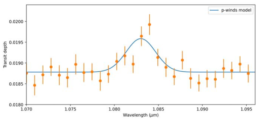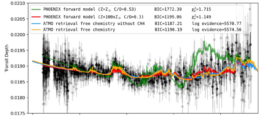With JWST up and running, astronomers are getting a first look at the quirks of individual exoplanets. Features never before examined are coming into view: for instance, a recent study has revealed that while HAT-P-18b may not have much methane, it does have a tiny tail.
JWST Shows Off, Finds a Corgi
Now more than a year past its launch, JWST is finally doing what it was designed to do: collecting photons and wowing astronomers with the precision of its data. One of the earliest flexes of its scientific power occurred last summer, when it trained its attention on the transit of a Jupiter-sized, Saturn-mass exoplanet named HAT-P-18b.
While the team, led by Guangwei Fu (Johns Hopkins University), found several molecules in the upper atmosphere of the planet using the Near Infrared Imager and Slitless Spectrograph (NIRISS) instrument, what they didn’t find was more surprising.

A subsample of the data, orange, and the best-fit model, blue, showing the helium absorption signature. The y-axis is in units of transit depth, meaning enhanced absorption appears as a positive bump. [Fu et al. 2022]
The first of these surprises was a helium absorption signature, but not surrounding the planet: instead, their results indicate that HAT-P-18b is dragging along a faint tail of escaping helium. Similar features have been spotted trailing behind other planets, but this one was so subtle that it was previously missed by ground based observatories. In other words, HAT-P-18b is the corgi of the exoplanets: it has a tail, but it’s not a dominant structure.
But what about methane?
The second surprise concerned a molecule not displaced from the planet, but possibly missing entirely. One of the primary motivations for targeting HAT-P-18b specifically is its position in a uniquely helpful corner of parameter space for modelers working on a methane mystery.
Hot planets with surface temperatures over 1000K are not expected to have any methane in their atmospheres, since thermodynamics at these extreme conditions prefer other species. However, simple models suggest that any worlds cooler than this should show signs of absorption caused by methane molecules in the upper atmosphere intercepting photons with a specific wavelength.
Strangely, however, this prediction has not panned out in previous studies. Searches of several planets that should have held methane turned up none. This tension called for a closer look: were the assumptions baked into the models wrong, or was there something strange about the first worlds surveyed? With an equilibrium temperature of 800K, HAT-P-18b was the perfect target to help move the needle one way or another.

The NIRISS data, black, and several possible model atmospheres to explain it, colored on top. The green and red models were produced assuming equilibrium chemistry. The x-axis denotes wavelength, and the ticks range linearly from 0.5 to 2.5 microns. [Fu et al. 2022]
In all, JWST revealed HAT-P-18b to be a strange world, one which subverts our expectations of atmospheric chemistry but charms with a helium tail. We’ll have to wait for JWST observations of other planets before we know just how weird either of those traits truly is.
Citation
“Water and an Escaping Helium Tail Detected in the Hazy and Methane-depleted Atmosphere of HAT-P-18b from JWST NIRISS/SOSS,” Guangwei Fu et al 2022 ApJL 940 L35. doi:10.3847/2041-8213/ac9977

